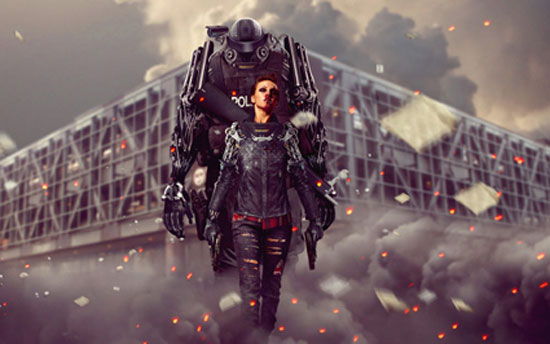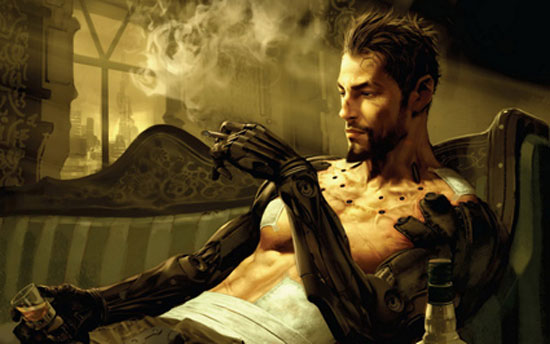In the summer of 1995, I visited the MIT Media Lab and met two graduate students who were working on computers that could be worn (wearable) and advanced human-machine interaction environments. Those guys happily called themselves cyborgs. Steve Mann was connected to the computer via satellite signals; next to the antenna he had on his head, he wore a camera that constantly transmitted images to two miniature television screens which he wore like glasses. He could turn the camera so that it showed things upside down or sideways, which he did in order to see how long it takes his brain to get used to such unnatural images. Or he could adjust the camera so that it “saw” electrical lines on the walls or even identify the power lines hidden in cameras in the Harvand Square stores. He transmitted his recordings to his website on the internet, which cost him the ban from various stores. Steve called his condition “mediated reality,” because everything he saw was mediated by his camera.
Steve’s partner, Thad Starner, was working on augmented reality. He was wearing a small laser that created a small computer screen on his retina. With the other eye he saw the normal, natural world. He controlled the computer with a controller that needed only one of his hands. He also had wireless access to the internet. For most of his time he lived simultaneously at the university and in cyberspace, with his senses affected by both worlds together.

Within a few years, these two cyborgs increased numerically, and they became a small group of students who were experimenting with various types of wearable computers, which they constantly improved. Research into advanced interaction environments and electric power technologies continues, as many young people believe that being a cyborg makes them better.
These cyborgs are simultaneously cyborg-logicians, and they consciously work in favor of the expansion of the synthesis of capabilities between humans and machines. However, there are many more cyborg-logicians, scientists and technicians, either using this term for themselves or not: computer designers working on interaction environments, surgeons, industrial designers developing tools and machines of prosthetic parts. There is also another group of cyborg-logicians, who are concerned with the social and philosophical consequences of our cyborg-ization.
Others are university professors trying to integrate these developments into a perspective in relation to the future, without resorting to the use of the concept of cyborg. The historian David Channell considers the current phase of our culture to be like the fusion of two distinct ideals of the Western world, for the class of the organic world (“the great chain of being”) and for mechanical rationality (“the universe / clock”). He argues that today these two formerly distinct ideas are merging into one, in the idea of the living machine. Bruce Mazlish, from the history department of MIT, has a slightly different opinion, a hymn to human epic against the historical illusions of our kind. This epic begins with the rejection of the belief that we are at the center of the world (thanks to the Copernican revolution), continues with the rejection of the belief that we differ fundamentally from animals (the theory of evolution), continues with the observation that we are not entirely rational (thanks to Freud and the unconscious). Finally, the “fourth discontinuity,” as he calls it in a book with the same title, must be overcome. This “fourth discontinuity” is the technical distinction that we created between the organic world and life on one side and machines on the other.
Some people have begun to perceive the Earth as a single cyborg system. Donna Haraway supported this, referring to Gaia theory, stating that the biosphere is an auto-regulating system, that Gaia is a “cyborg world.” If one takes into account the dominance of humans over nature and human technologies within the biosphere, then such a claim seems to stand.
…
In 1960, the internationally renowned pianist, as well as a friend of computers, Manfred Clynes, and the psychiatrist Nathan Kline, created the term “cyborg” and began to analyze its consequences, from the perspective of evolution. It is clear that if the human species shapes itself so that it can live in space or other hostile environments, the dynamics of natural evolution have been surpassed, at least in the medium term, by technical evolution. We are now in a position to consciously shape our own evolution. Technical evolution is no longer simply the deliberate improvement of cultivated animals, which Darwin studied at one time; it now also includes the direct shaping of human bodies and genes. For now, our interventions are still crude, but new sciences promise that we will soon be able to create beings, with our own material, which will not even be considered human. Whatever the motives, whether it is profit, power, or the maximization of human potential, this process is fundamentally political. In a political way, the values of the posthuman will be determined.
The possibility of post-human cyborgs frightens some people and fascinates others. We saw the starting point of this polarization in discussions about human cloning. The Catholic Church and many governments called for the prohibition of human cloning experiments, while scientists called for the freedom for even more research.
However, these simple polarizations do not help. Firstly, there are many different types of cyborgs, and many different ways to categorize them. The world usually thinks that cyborgs are people who have lost some functions and these have been replaced in some mechanical way, with a tendency to make their lives “normal” again. A person with a pacemaker is cyborg, for example. However, for a long time we largely ignored the ethical consequences of reshaping and enhancing the state of posthumanity. Only in 1997 did the fund for the study of the Human Genome finance research into the ethical consequences of using genetic engineering in the enhancement and reshaping of people. Other researchers have proposed ways of analyzing cyborgs that focus on their technological level (meta- or/and semi-cyborgs for example) estimating the ratio between the biological and mechanical elements of the organism being studied.

The second problem with simple polarizations is that it can ultimately concern issues that are not the most important. Steven Mentor, Heidi Figueroa-Sarriera and I dealt with this side of the matter in the essay “Cyborgology” in The Cyborg Handbook, where we analyze the novel by Maureen McHugh China Mountain Zhang. The protagonist of the novel, a Sino-American engineer, faces his own cyborgification when he realizes that: “soon it may be impossible to say where human ends and machines begin.” We supported that such confusion is fine because:
There are much more important distinctions that one must make, between justice and injustice, between creativity and destruction, between stability and instability, between pleasure and pain, between knowledge and ignorance, between effectiveness and ineffectiveness, between beauty and ugliness… Sometimes, most people considered the distinction between the artificial and the natural, the human and the mechanical, the organic and the manufactured, to be the central dualisms of life. But the cyborg form demonstrates that this is not the case…
That essay ends with a call to overcome dualistic epistemologies, and to adopt the epistemology of cyborgs:
Position – Opposition – Synthesis – Addition, and again
…
Chris Hables Gray, excerpt from “cyborg citizen”, 2001 (translation: Z. S.)
